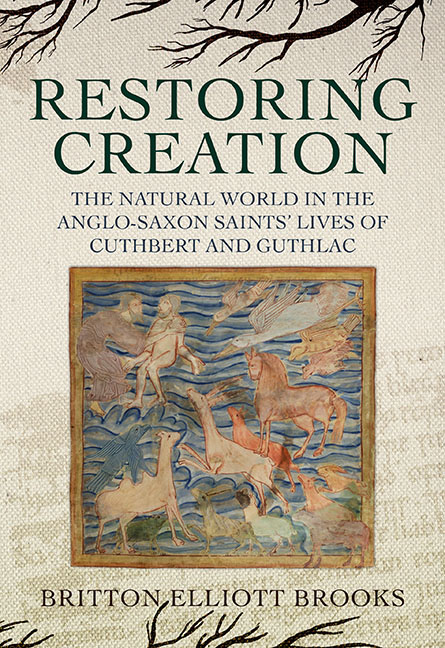 Restoring Creation: The Natural World in the Anglo-Saxon Saints' Lives of Cuthbert and Guthlac
Restoring Creation: The Natural World in the Anglo-Saxon Saints' Lives of Cuthbert and Guthlac Book contents
- Frontmatter
- Contents
- Acknowledgements
- Abbreviations
- Introduction
- 1 Monastic Obedience and Prelapsarian Cosmography: The Anonymous Vita Sancti Cuthberti
- 2 Ruminative Poetry and the Divine Office: Bede's Metrical Vita Sancti Cuthberti
- 3 Bede's Exegesis and Developmental Sanctity: The Prose Vita Sancti Cuthberti
- 4 Enargaeic Landscapes and Spiritual Progression: Felix's Vita Sancti Guthlaci
- 5 Landscape Lexis and Creation Restored: The Old English Prose Life of Guthlac and Guthlac A
- Conclusion: Afterlives of Cuthbert and Guthlac
- Bibliography
- Index
1 - Monastic Obedience and Prelapsarian Cosmography: The Anonymous Vita Sancti Cuthberti
Published online by Cambridge University Press: 18 September 2019
- Frontmatter
- Contents
- Acknowledgements
- Abbreviations
- Introduction
- 1 Monastic Obedience and Prelapsarian Cosmography: The Anonymous Vita Sancti Cuthberti
- 2 Ruminative Poetry and the Divine Office: Bede's Metrical Vita Sancti Cuthberti
- 3 Bede's Exegesis and Developmental Sanctity: The Prose Vita Sancti Cuthberti
- 4 Enargaeic Landscapes and Spiritual Progression: Felix's Vita Sancti Guthlaci
- 5 Landscape Lexis and Creation Restored: The Old English Prose Life of Guthlac and Guthlac A
- Conclusion: Afterlives of Cuthbert and Guthlac
- Bibliography
- Index
Summary
THE ANONYMOUS Vita Sancti Cuthberti (VCA) has typically been interpreted as the ground from which Bede built his two lives of Cuthbert, rather than as a text with its own internal coherence, structure, and themes. Cuthbert's interactions with Creation in the VCA have likewise been read in relation to Bede's adaptation of them in his vitae. When the VCA is examined on its own, however, in the light of its theological context, which informs the thematic and structural choices in the text, these miracles are better understood as functioning within a postlapsarian world delineated by Augustinian/Bedan exegesis. The VCA explores the nature of Cuthbert's ability to restore Creation by means of obedience, focusing on the fundamental moment of disobedience at the Fall; by Cuthbert's perfect saintly obedience humanity's rightful place in the divine hierarchy is restored, and for a moment the world returns to its prelapsarian state. Creation in these miracles is not merely a set of signifiers pointing to divine truth, nor is it a simple point of contrast for humanity. The VCA instead reveals how monastic obedience can participate in the restoration of prelapsarian divine cosmography, how the imitative nature of order in the monastery is not purely an earthly construct, but part of how the world is transformed. The VCA grounds this depiction of sanctity's transformative ability in the world of early eighth-century Northumbria through physical descriptions of the landscape, as well as by the textual creation of potential sites for a specific kind of pilgrimage. The result is a set of miracles firmly fixed in the traversable and familiar landscape, which points to the ability of the obedient to transform the daily hardships of life, and thereby participate in the miraculous.
The VCA was composed at some time between the translation of Cuthbert's uncorrupt corpse in 698 and the death of King Aldfrith in 705. This was a period of novel stability for the monastery at Lindisfarne after considerable turmoil, including the excommunication of Bishop Wilfrid and his followers after the council at Austerfield in 703.4In light of this stability, it is unsurprising that Lindisfarne was keen to promote its newly translated saint and expand its influence.
- Type
- Chapter
- Information
- Restoring Creation: The Natural World in the Anglo-Saxon Saints' Lives of Cuthbert and GuthlacThe Natural World in the Anglo-Saxon Saints’ Lives of Cuthbert and Guthlac, pp. 19 - 66Publisher: Boydell & BrewerPrint publication year: 2019
